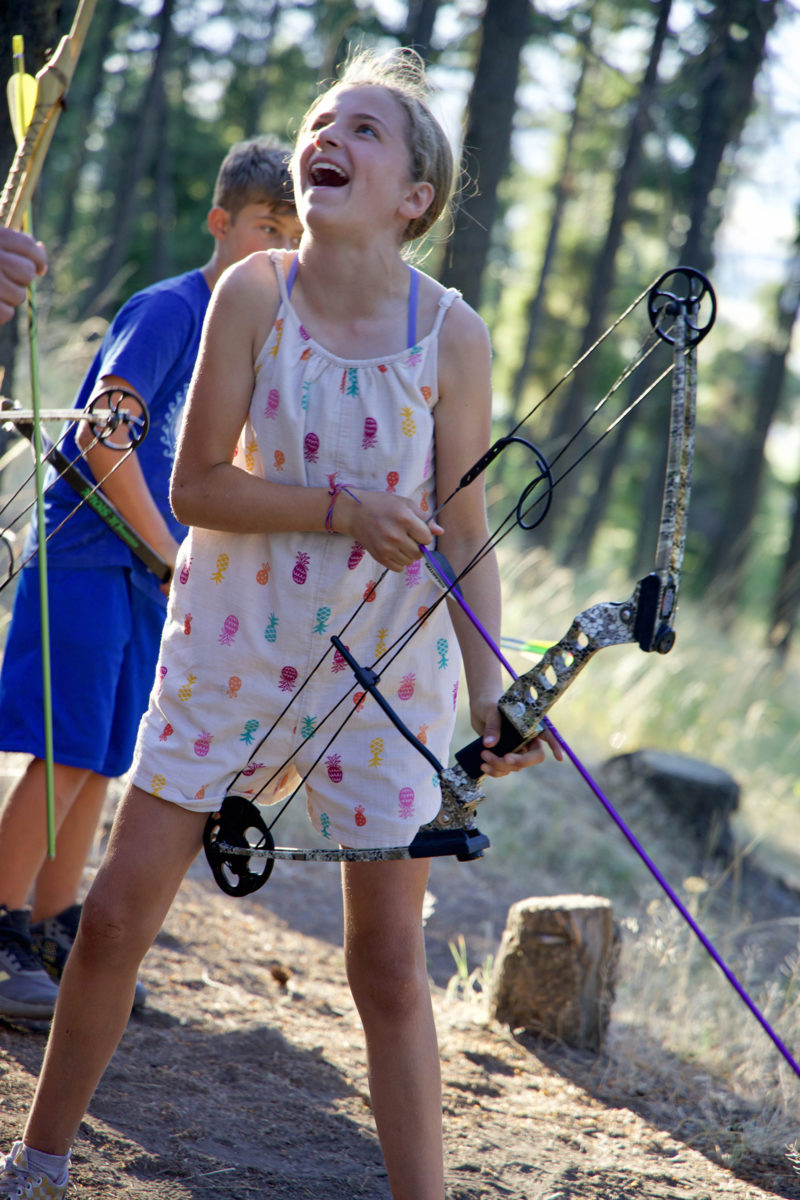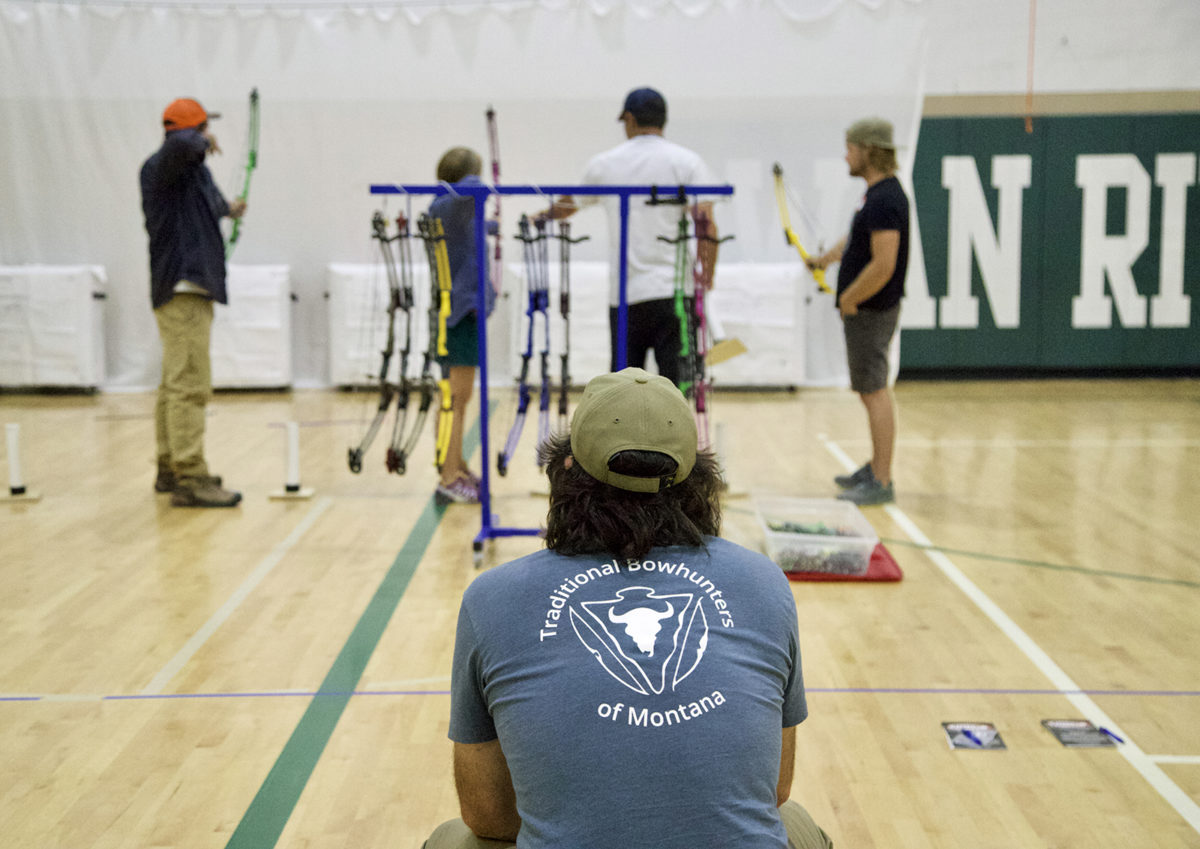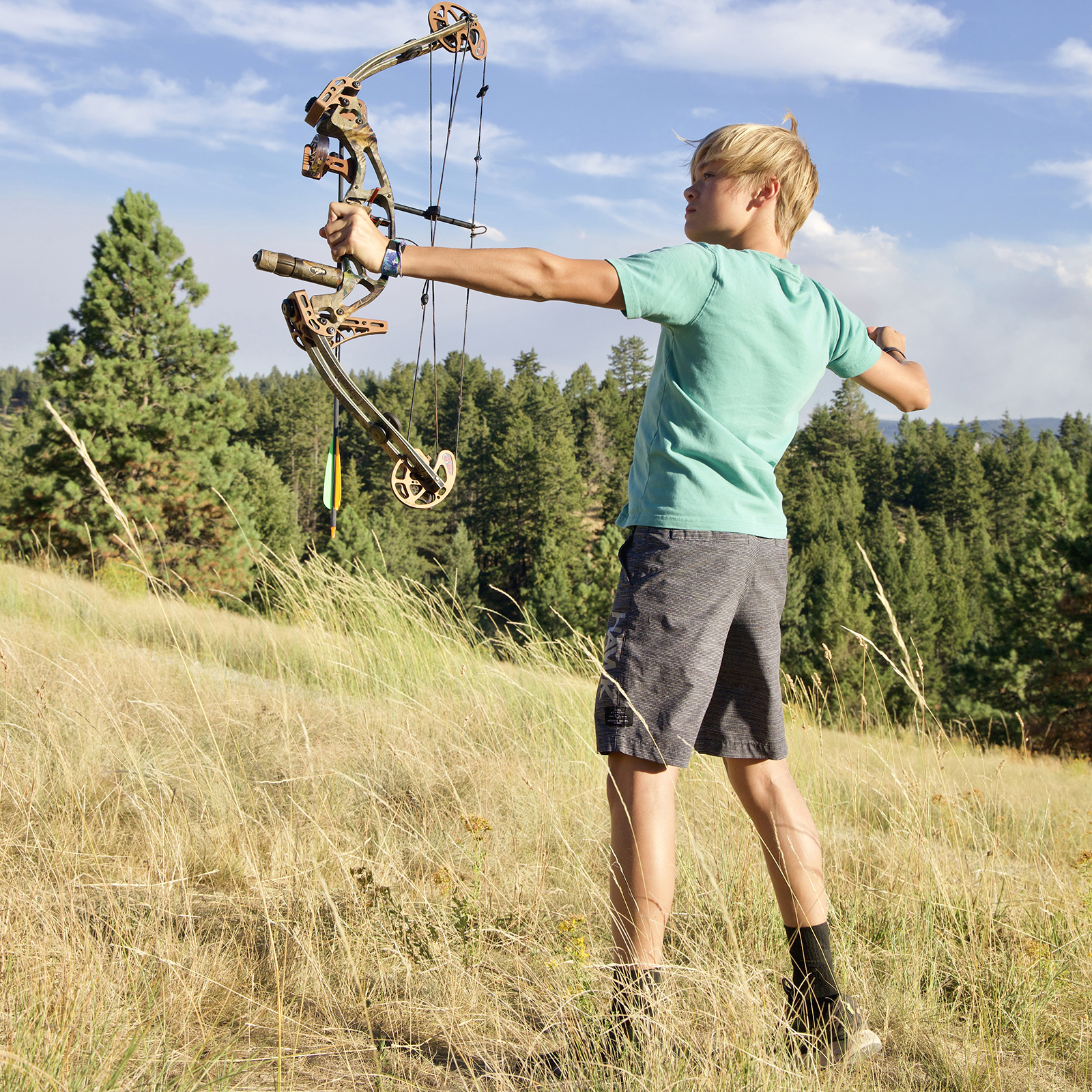Bow and arrows in hand, a group of young archers march up the hill along the Lone Pine Archery Trail as the sun streams over the ridge. Their faces shine from the excitement of the outing.
Brian Schwartz, manager of Lone Pine State Park southwest of Kalispell, is the leader of this informal outing, which includes three of his four children and neighbor Lance Heuscher and his kids. He says that kids’ interest in archery has soared in recent years – speculating that it might be in part because of popular movies such as Hunger Games and Avatar portraying the romance of the sport.
Schwartz is certified to teach archery through the National Archery in Schools Program (NASP) used for school and park archery classes throughout the Flathead Valley. Besides teaching other people’s Kids, he started each of his four children at 4 years old by introducing a simple bow fashioned from PVC pipe. Selah, 9, is his youngest child and also one of the youngest in the group enjoying the sport on the mild and blustery summer evening. When asked what she likes about archery she says, “I like getting out in the forest – and adventuring!” Her older brothers, Logan, 13, and Greyson, 11, both say they like when they make a good shot. “Oh, me too!” Selah adds.
The group stops at the first of six shooting stations to take turns hitting a square target faced with a photograph of an elk. Schwartz notes that the forested trail and its varying elevation are closer to real life and a hunting environment. The Lone Pine Archery Trail is the only public outdoor archery site in the Flathead Valley. Families use the trail as well as hunters preparing for fall. A voluntary sign-in at the trailhead tallied 2,000 archers last year, which only shows a portion of the actual numbers using the trail.
Archery classes and events are also held at Lone Pine Park by setting up a separate area for the highly formulated NASP style of teaching. Sometimes they use empty milk jugs as targets or balloons, which make a loud noise when struck and add to the excitement of a successful shot. Schwartz says one child who had never picked up a bow filled a small circle on the target with arrows at an event. “He was a natural.”
NASP includes students in grades four through 12 with the aim to improve educational performance by learning focus, self-control, discipline, patience and the life lessons required to be successful in the classroom and in life. In their words, “NASP is an activity that doesn’t discriminate based on popularity, athletic skill, gender, size, or academic ability.” Equipment is standardized to keep the playing field even.

Since its inception in 2002, its website says that NASP has put a bow and arrow in the hand of over 18 million students and over 91,000 teachers have been trained. Basic Archery Instructors (BAI) learn how to set up and run a safe range and teach the program. The program is designed with a 10-hour curriculum that includes teaching the 11 steps to archery success. They learn about the equipment and its parts – such as the nock of an arrow, which is a notch that attaches to the bowstring to stabilize the arrow on the string – or the fletching, which are the feathers or plastic at the end of the arrow. Equipment to get started is offered at a substantial discount at the NASP website naspschool.org. Many schools receive donations or grants to help fund the program.
Montana Fish, Wildlife and Parks (FWP) Education Specialist Ryan Schmaltz holds training sessions for teachers throughout the state. Most are physical education teachers, but other school staff and community members also take the course. Schmaltz notes that the program is beneficial not only to the individual but also to the school and community.
By integrating archery into the curriculum, every student gets a chance to participate. He notes that process is emphasized over scores.
Even though it can be held outdoors, the indoor format allows it to be done year-round. Schmaltz notes, “It is super structured.” The controlled environment can make instruction simpler and safer. Shooting stations are set up with an arrow curtain to stop errant arrows.
Swan River School in Bigfork added the program in 2021. It was one of the first things JJ Lamb did when he became principal of the school. He taught PE and archery in Missoula and observed how much kids enjoyed and benefited from archery. “Some kids have never done it before and when they hit a target – they light up.”
Lamb is a Montana native and did archery from a young age near their home. He says, “Archery is imbedded in Montana.”
He says archery can also be a life lesson, “If kids focus, breathe and overcome obstacles they can be successful.”
Swan River teacher and coach Bud Gaiser has found that his gymnastics coaching background plays to his strength while teaching archery because both sports are very routine.
“Everyone starts with a string bow which is a length of string that is used to measure and practice drawing and posture. It is very self-regulating. If you want to shoot you must first safely accomplish all preliminary tasks. Anyone can follow the steps to become a proficient archer,” he says.
He says that it is an exciting school activity for kids and provides a way to improve skills for bow hunting. He also finds that some of his best archers aren’t interested in hunting, they simply like the repetitive nature of archery. “It has also opened the door to other activities that need to follow the same procedural formula, like fly fishing and first aid, for instance.”
Gaiser already has plans to expand the program with the addition of 3D shooting and participation in tournaments throughout the state.


Arlee teacher Susan Carney has been teaching archery in school for nearly 18 years, since the beginning of NASP in Montana. In addition to the in-school program, the Arlee School has hosted trainings and tournaments. Her daughter Taylor grew up with archery at home and through the school program. She recently earned her NASP certification, which Susan says has enabled Taylor to give back to a program that helped her. Susan says, “We grew our family tradition.” Mother and daughter both worked with student Karma Tibbets, winner of the girl’s state championship in 2022.
The Arlee School along with other archers in the area will soon have access to a new archery range trail in Big Arm across the highway from the entrance to the Big Arm State Park. The new facility is projected to be completed in the spring of 2023 and will provide students and local archers a place to practice with a covered firing line and an archery trail with 12 shooting stations.
Lone Pine will double its archery trail with the addition of 9.3 acres and six new shooting stations next to the existing trail with six stations. The expansion should be completed by early 2023, possibly earlier. The addition is timely as the interest in the sport grows. Dillon Tabish, FWP Communications and Education Program Director for Region 1, says they added at least five schools last year bringing their numbers up to 20 schools in Northwest Montana enrolled in the archery program managed by the FWP. He notes that as interest and participation grows, the two archery trails are a great amenity for the NASP programs.
Back at Lone Pine, Schwartz tells the kids it’s time to wrap it up as shadows grow long and the sun sinks behind the ridge. There have been varying amounts of success. A handful of arrows flopped a few feet from the bow and some hit the target.
One little girl began the outing by declaring, “I’m bad at this. I can’t do this.” When she appeared hesitant and discouraged, Schwartz and Heuscher continued to encourage her. At the next target, her form improved along with her concentration. She released the bowstring and this time the arrow streaked ahead – and hit the target. Her face lit up.
“I love this. It is so fun!”
